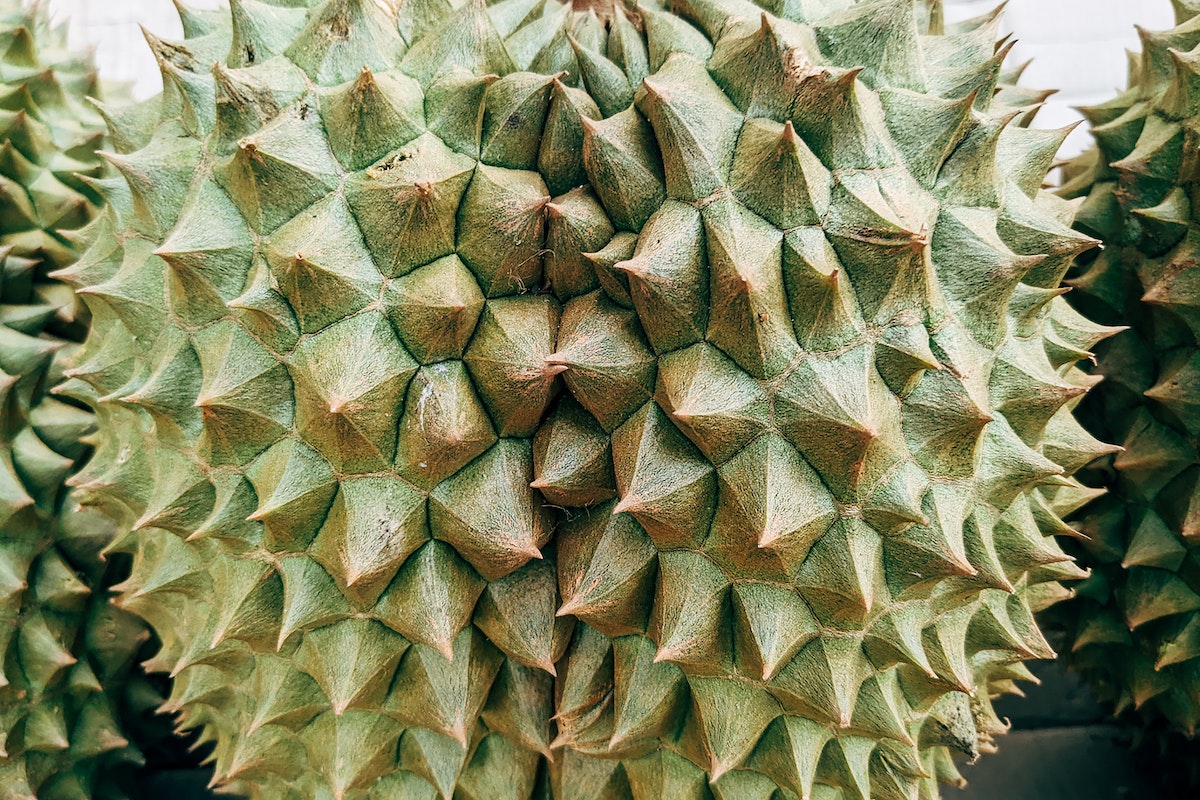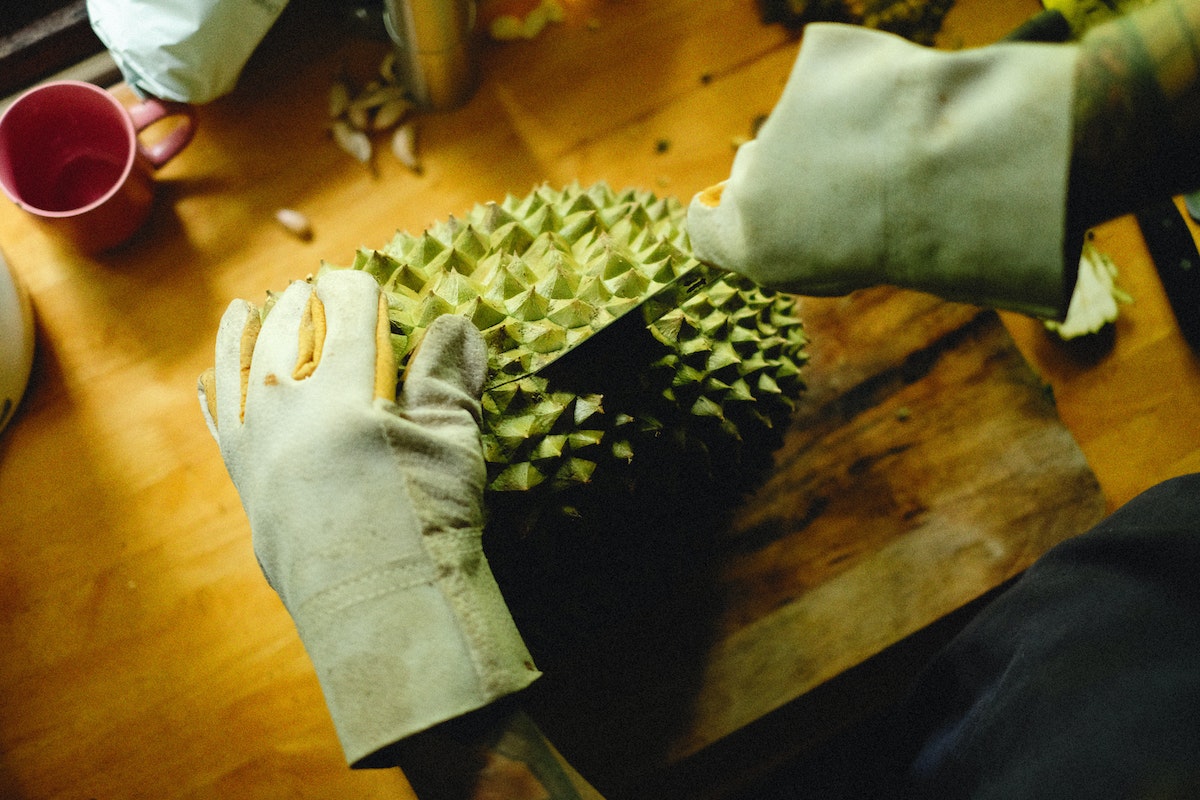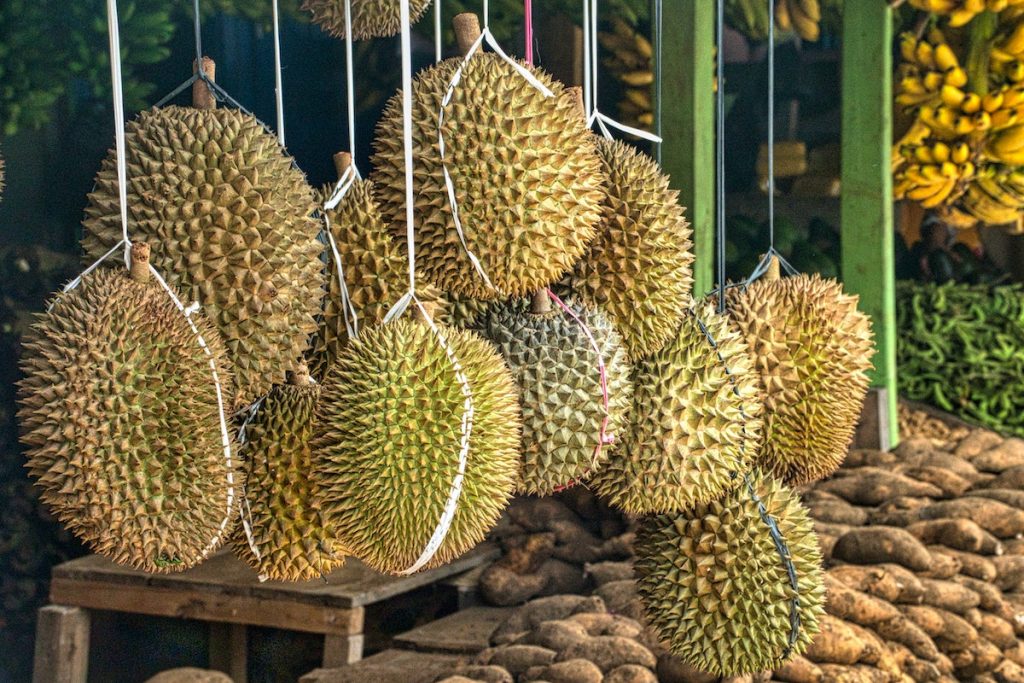The tropical fruit known as durian is a polarizing food that engenders either love or hate. This fruit can be eaten raw or cooked and is primarily produced in Thailand, Malaysia, Indonesia, and the Philippines. It has gained popularity throughout Asia and can be purchased in Asian markets in the United States.
Quick Overview
The durian has a thick, spiny rind protects its sweet, slightly bitter, and creamy flesh. It can grow up to one foot in length and six inches in width but usually only provides around two cups of edible flesh.
What is Durian?
The durian is a large, spiky, greenish-brown fruit popular in Southeast Asia and often called the “king of fruits.” It has a strong odor when it’s ripe, which can differ depending on the type of durian. Although some people dislike the smell, others enjoy it. The fruit’s odor is so strong that it has been prohibited in certain public areas and modes of transportation.
When durians are ripe, they tend to crack open, which makes it easy to extract the edible flesh known for its texture and flavor. A large knife or cleaver can be used to get to the flesh. The flesh can either be consumed raw or cooked, and it comes in white, yellow, or red colors. Due to its short season, limited shelf-life, and high demand, it is relatively expensive, mainly when imported.
Description of Durian’s Appearance, Size, and Distinctive Features
Durian has a thick, leathery rind that turns from green to yellow when it’s ripe. It can range from small to large. Durian is characterized by its strong aroma and distinctive spikey shape, which give it an intimidating appearance. Inside the rind are several seeds surrounded by flesh. The flavor of the flesh is sweet with a slightly bitter aftertaste, and its texture can range from creamy to chunky.
Explanation of its Spiky Exterior and Strong Odor

Fruits have spikes to protect themselves from animals that try to eat them. Durian spikes, for example, are modified leaves that serve as a barrier against predators. These spikes make it challenging for animals to open durian and consume its flesh. The tough, sharp durian skin also deters potential predators from accessing the fruit’s fleshy interior.
A team of scientists in Singapore, who love durians, have discovered the gene responsible for the fruit’s strong smell. They suggest that this discovery could produce durians with a milder or no smell in the future. However, some people who appreciate the fruit’s distinct strong smell have conflicting opinions about the development.
A group of anonymous durian enthusiasts privately funded a team of five cancer scientists to conduct research on the fruit for three years. The researchers have successfully created the world’s first complete genetic map of the durian fruit. According to the team, the strong smell of the durian fruit plays a significant role in attracting animals to consume it, thus aiding the dispersion of its seeds in the wild.
What Does Durian Taste Like?
The durian fruit has varying descriptions by different people. It is popular in Southeast Asia and loved by many. Some say its taste is similar to almond, while others describe it as having a custard-like texture. The flesh is uniquely tender and creamy when it’s ripe. The fruit is not too acidic, overly sweet, or juicy. Lastly, the odor, flavor, and color of the fruit can vary based on the type of durian.
Durian fruit has a distinct taste that can vary depending on several factors, such as the fruit variety, ripeness, and growing conditions. While some people describe the taste of durian as sweet, like ice cream, others compare it to eating cheese. Whether you like its taste and texture will ultimately depend on your taste preferences.
How To Choose A Ripe Durian?
Southeast Asians get very excited about the durian season, which happens twice a year. Although the strong smell may be a turn-off for some, those who have tasted it can attest to its exceptional flavor. It is even used in various dishes such as rice and curry.
Knowing how to choose the right durian is crucial. It may have a strong and bitter taste if it’s too ripe, while it will have hard and bland flesh if it’s not ripe enough. Even though many durians in the West are frozen imports, the strategies for finding the ideal fruit can still be used. Guidance on Selecting a Ripe and High-Quality Durian
Durians are usually sold in bunches and should be heavy for their size. It’s a delicate process involving using your senses of smell, hearing, and touch.
- Opt for Fresh Fruit – To fully appreciate durian, it’s best to skip the Styrofoam containers of pre-cut fruit and instead choose a whole fruit.
- Listen to the Fruit – If the durian is not frozen, gently pick it up with both hands. Use tea towels if the thorns hurt. Then, hold the fruit beside your ear and shake it gently. You should listen for dull, subtle knocks. If the fruit makes no sound, it’s too ripe. If it makes a hard knocking sound, it’s not ripe enough.
- Smell the Fruit – To further narrow your selection of durians, use your sense of smell after identifying the correct knocking sounds. Hold the durian an inch away from your nose and take a whiff. If the scent is slightly fragrant, then the fruit is likely ripe. The durian is probably not yet ripe if it smells like unripe fruit. And if the aroma is too strong and overpowering, the flesh may be too soft and gooey. Look for a durian with a moderate smell—not too raw and not too strong.
Suggestions for the Best time and Place to Try Durian
Durian season is heavily dependent on the weather. Durian trees require substantial rainfall to produce fruit, and they typically yield fruit only once or twice a year. Consequently, Southeast Asia experiences two durian seasons annually.
The main durian season is from June to September, followed by a shorter season from December to February. To get the most delicious durian, waiting for the main season when the fruits are at their peak is recommended.
To choose a ripe durian, find one that feels lighter and has a firm stem. Gently shake the fruit to ensure the seeds inside are loose, or use a knife to check for stickiness. If you want to enjoy durian’s flavor even when it’s out of season, you can try various durian-based products like freeze-dried durian chips or durian flavor mung bean cakes.
Instructions on How to Open and Eat Durian Properly

To open a durian, locate the faint brownish outlines of a five-pointed star at the base of the fruit. These outlines are called sutures, and they separate the different segments of the durian. Simply follow these lines to split open the durian easily.
Get a knife with a strong and sharp point to open up a durian. Hold the durian with a piece of cloth in one hand and use the other hand to poke straight into the middle of the “star” with the knife. Twist the knife left and right a few times after it has penetrated the durian by about two inches. This should cause the sutures or lines of the different segments to open up. Finally, cut through the durian along these lines.
To eat the durian, use your hands to separate its segments as it opens up. Cover your hands with a cloth to avoid getting poked by the thorns. Once the segments are separated, you can remove the seeds and eat the flesh of the durian.
What Does Durian Smell Like?
According to a 2017 study published in Nature Genetics, the unpleasant odor of durian is due to its genetics. The study highlights that Musang King, a type of durian from Malaysia, has 46,000 genes in its full sequence and can be traced back to the cacao plant from 65 million years ago.
Musang King
The Musang King durian has greater activity in genes related to sulfur pathways compared to less-smelly durians, and this activity only occurs during the fruit’s ripening process, according to the study. The researchers believe this increased activity is associated with a gene called ACS that controls ethylene production, a plant hormone essential for ripening. Researchers have discovered that the gene is not only present in the durian fruit but is also expressed in the leaves and root stems.
Smell ad Attractant
The study indicates a possible link between MGL and ACS in durian fruit, which may involve the Yang cycle. Earlier research on durian has noted a connection between VSC production and increased ethylene production, but no genetic relationship has been proven yet. The study suggests that the smell of durian may serve as an attractant.
The strong odor emitted by ripening durian fruit suggests that primates attracted by smell, rather than animals attracted by sight, are likely its main means of dispersal.
According to the Nature Genetics report, there is still more to explore in studying durians. The fruit has become popular in commercial markets, creating multiple cultivars that have varying prices but are not always genuine. If a high-quality genome assembly is created, it can determine traits unique to each cultivar, allowing for quick quality control through molecular barcoding.
Pairing Durian with Other Foods or Beverages
Indulging in durian is an experience of creamy, sweet, bitter, and bold flavors all in one bite. Its pure, natural flesh is delicious on its own without any accompaniment. However, incorporating it into sweet treats or pairing it with other foods can enhance its flavor and provide a new way to enjoy it. Just like a hero needs a sidekick, durian pairs fabulously well with other flavors.
Recommending Flavors and Dishes that Go Well with Durian
- Durian and Mangosteen – Mangosteen is a highly-praised fruit known as the queen of fruits due to its scrumptious taste and numerous health benefits. Mangosteen is classified as a “cooling” fruit in Traditional Chinese Medicine (TCM). It can help lessen the heat produced after consuming durian flesh. This is why they are often sold as a combination, particularly in Southeast Asia. The divine richness and creaminess of durian match the sweet and juicy mangosteen, resulting in a blend of divine flavors.
- Saltwater and Durian – In TCM, durian is classified as a “heaty” food. Some people recommend drinking salt water poured into the empty durian husk to counteract this. Although it is a long-standing tradition and belief in the durian community, there is no scientific evidence to back up whether or not it works. Nonetheless, it is commonly believed that consuming salt water helps to reduce toxins and heaviness in the body.
- Cheese-Baked Durian – In Asia, it’s common to find desserts that combine durian and cheese, which create a surprisingly pleasant mix of flavors. The Basque burnt durian cheesecake is the most popular, but some people in Indonesia and Thailand prefer a simpler pairing that highlights the distinct taste of each ingredient. One easy dish to make at home is cheese-baked durian, but for those who love a smoky flavor, it’s also possible to roast the entire durian shell over an open fire, open it up, and add cheese on top of the fruit.
- Luo Han Guo Tea – Monk Fruit, also known as Luo Han Guo, is a small green fruit from southern China often used as a natural sweetener and can be made into tea. Traditional Chinese Medicine suggests it can help alleviate lung heat after consuming durian. To prepare tea, boil the fruit in water for about ten minutes and sweeten it with rock sugar or honey.
- Durian Chicken Soup – The durian chicken soup is traditionally prepared using musang king and red prawn durian. It is popular in Thailand and China and is believed to offer several health benefits, such as promoting blood circulation, recovery, and strengthening. The fruit’s characteristic flavor is usually moderated by slow cooking, which also enhances the taste of the chicken and broth.
- Chrysanthemum and Honeysuckle Tea – In Asia, Chrysanthemum and honeysuckle tea is a well-known beverage with several health benefits. According to TCM, this tea has a cooling effect that helps neutralize the body’s heat after consuming durian. It is also useful in relieving headaches and sore throats caused by internal heat. Furthermore, it is believed to help reduce blood pressure levels.
Sharing Popular Combinations or Traditional Pairings
Here are some popular combinations of durian with other food
- Durian and Coconut – Durian is often paired with coconut in many Southeast Asian desserts. Depending on the type of dessert, durian and coconut are usually combined in some sort of pudding or cake. In addition to providing a unique flavor combination, these two ingredients offer different textures that complement each other perfectly.
- Durian and Rice – Durian is commonly used to add flavor and texture to dishes such as curries, fried rice, and other savory stews. Durian’s creamy flesh pairs well with sticky rice or jasmine rice, giving the dish an unmistakable aroma.
- Durian and Palm Sugar – Durian can also be enjoyed in raw form or cooked with palm sugar. Combining these two ingredients creates a sweet and creamy dessert popular in Thailand and Malaysia.
- Durian and Green Tea – Durian and green tea are two ingredients with different flavors and aromas, but they make for an interesting combination when paired together. The subtle taste of the green tea pairs nicely with durian’s bold flavor, resulting in a unique tea experience that will transport you to the tropics.
- Durian and Chocolate – Durian’s unique flavor pairs perfectly with chocolate in desserts such as cakes, mousses, puddings, and ice cream. It gives the dish a creamy texture and an interesting aroma that will tantalize your taste buds. Combining these two ingredients is prevalent in Southeast Asia, where it is often served on special occasions.
Durian Varieties and Seasonality
Durian fruit comes in various types with different sweetness, creaminess, and seed size levels. Though the exact count of these types may vary, only around thirty are safe to eat. Musang King and Monthong are the most well-liked ones, but all durian types share the same strong odor.
Musang King
The Musang King or Mao Shan Wang is a highly popular type of durian. When exported, it is renowned for its top quality, creaminess, richness, and high market value. Malaysia is the leading producer of Musang King durian, while Singapore is one of its biggest fans.
Durian Tekka
The “Musang Queen” is an alternate name for Durian Tekka, a durian fruit originally found in Malaysia. Compared to other fruits, it has relatively big seeds. This large oval-shaped fruit has pale yellow flesh with a creamy texture and strong flavor. It has a distinctive smell and is less commonly found than other durian varieties.
D24
The D24 durian, also called Durian Sultan, has a round shape, and its husk is green-brown. One of its identifying characteristics is the hook-shaped spikes and small, rounded seam on the bottom. The flesh of the D24 is bright yellow, firm, and has a slightly dry texture. Its taste is bittersweet and typically a bit sweeter than the Musang King.
Kampung Durian
Compared to other durian varieties, some people consider kampung durian the best. These durians are harvested from wild trees, making them the most affordable type. Although they are usually irregularly shaped and have thin flesh, the taste can vary from tree to tree, resulting in unique and amazing flavors due to their non-cultivated nature.
Monthong
The Monthong durian is a popular type of durian fruit grown in Thailand and is known for its sweet taste and mild flavor with notes of vanilla and caramel. Unlike other durian varieties, it has a low pungency level, making it an excellent choice for first-timers. Additionally, its flesh has a longer shelf life, making it easier to export.
Health Benefits of Durian
In traditional Malaysian Medicine, various parts of the durian plant, such as leaves, husk, roots, and fruit, treat illnesses such as high fever, jaundice, and skin conditions.
According to studies, durian fruit provides the following health benefits:
Lowers Cancer Risk
Durian may lower the chance of getting cancer because of its antioxidants which can stop cancer-causing free radicals. According to a study done in a test tube, durian extract stopped the growth of a certain type of breast cancer cells.
Reduces Blood Sugar Levels
Durian may help lower blood sugar levels as it has a lower glycemic index (GI) than other tropical fruits, reducing the chances of a spike in blood sugar levels.
Prevents Heart Disease

Durian has compounds that can lower cholesterol levels and lessen the risk of atherosclerosis, which is the hardening of the arteries and can lead to heart disease.
Fights Infections
The rind contains compounds that can fight against bacterial and yeast infections.
Although the studies on durian demonstrate potential benefits, most have been conducted on animals or in vitro. Therefore, it is crucial to conduct controlled studies on humans to confirm the health benefits of durian before making any conclusive claims.
The Durian Experience
Overall, tasting durian is an experience unlike any other. It has a unique taste, aroma, and texture can be enjoyed in various ways. From snacks and desserts to drinks and soups, durian can bring creative recipes with a special touch. With its many health benefits and endless possibilities for culinary use, the King of Fruits is more than just a delicious snack – it is an experience. Whether sampling it for the first time or diving further into its unique flavors, durian fruit will surely leave you wanting more.
Sharing Personal Anecdotes or Stories About Tasting Durian
One person remembers the first time he tasted durian. The aroma was so strong that it almost knocked him out of his chair. But when he finally mustered enough courage to take a bite, it was like eating a creamy cloud – sweet and rich with an underlying hint of bitterness. It was unlike anything I had ever tasted before.
From that moment on, he was hooked, and soon enough, he became an avid durian fan. He would seek out new flavors in different countries, attend celebrations dedicated to the fruit, and even create unique recipes showcasing its unique taste.
Tasting durian can be a life-changing experience – so don’t let the smell scare you away! Take a bite, and you may just become a durian believer.
Some people also recommend that newbies take their first taste of durian in the company of others who have tasted it before. This will help to alleviate any fear or anxiety about trying something outside your comfort zone. Plus, with more experienced friends, you can get helpful advice on what to expect.
Finally, it’s important to remember that everyone has different tastes and experiences when tasting durian. So don’t feel discouraged if you don’t like it the first time – keep an open mind and try again! You will find something in durian that you love and appreciate. In no time, you can confidently say that you are a durian lover. And who knows, maybe you’ll even become a durian expert one day! The possibilities are endless when it comes to enjoying durian fruit. So go ahead and give it a try – your taste buds won’t regret it.
Expressing the Cultural Significance and Popularity of Durian in Certain Regions
Durian is a beloved fruit in Southeast Asia, especially Malaysia and Thailand. It is celebrated in various festivals annually and plays an essential role in cultural customs and traditions.
In Thai culture, durian symbolizes luck and prosperity due to its sweet taste and unique shape. It is often used as a gift or offering for special occasions, such as weddings and Birthdays. The fruit is also used in traditional ceremonies and to honor deceased ancestors.
In Malaysia, durian has been part of the national culture for centuries. Durian trees are often planted in cemeteries or near homes, believed to bring good luck and protection from harm. People also believe that eating durian brings strength and courage, and it’s commonly served to men before they go to battle.
Other Facts about Durian Fruit
Here are some facts about the durian you may not know about:
Around 30 Kinds of Durian Fruits Exist in the World
Did you know there are 30 recognized species of durians in the wild? However, only nine are edible. While Mao Shan Wang and D24 are popular varieties, many cultivators use cloning farming methods to create different looks and tastes through trial and error and human intervention. These durian varieties can be found in Thailand, Vietnam, Malaysia, Indonesia, the Philippines, and Singapore.
Durian Fruits Fall Once They Ripen
To determine if a durian is ripe, it is necessary to wait for it to fall from the tree naturally. Farmers used to sleep in their orchards to hear the fruit drop. However, due to the increasing value and cost of durians, they are no longer allowed to fall to the ground, which can negatively impact their price. As a durian enthusiast who organizes tours and tastings, I can confirm this to be true.
Currently, some farms use large nets to catch durians that fall from trees, while others employ workers to tie strings around the durian stem. This prevents the ripe fruit from falling to the ground and getting damaged by the tree’s sharp thorns.
Durian is Suitable for Many Meals
Durian, a fruit popular in Singapore, is often combined with unusual foods like pizza, steamboats, and chee cheong fun. While some may find this fascinating, the idea puts others off. It is even used as an ingredient in fried rice dishes and can be paired with white wine. However, it is essential to remember not to overindulge, as alcohol may prevent the fruit from breaking down properly in the body, resulting in a potential hangover.
Durian is a unique and beloved fruit in Southeast Asia that has a strong aroma and bold taste. It can be enjoyed in raw or cooked form and in snacks and desserts. Durian also offers a variety of health benefits, so don’t hesitate to give it a try! Keep an open mind when tasting durian for the first time – you never know, you may just become a durian believer! From its cultural significance to its endless possibilities in culinary settings, durian is sure to be an unforgettable experience you won’t want to miss.
FAQs
Here are some frequently asked questions about the taste of durian.
What does overripe durian taste like?
Overripe durian has a more intense flavor that can be slightly bitter. The texture becomes softer and stickier, making it harder to bite into.
Why does durian taste different?
Durian tastes different because of the unique combination of texture, aroma, and flavor. The taste can vary from sweet to bitter depending on the type and ripeness of the durian.
How can you tell if a durian is good?
A good durian should have a strong aroma and be firm to the touch. The husk should not have any dark spots or mold, and the fruit should feel heavy for its size.
Why do durians smell so bad?
Durians have an intense aroma that can be overpowering to some. The presence of amines and sulfur compounds in the fruit causes the smell.
Which durian is sweet or bitter?
The taste of durian varies depending on the variety. For example, Musang King and Monthong are known for their sweet flavor, while D24 is known for its bitterness.


